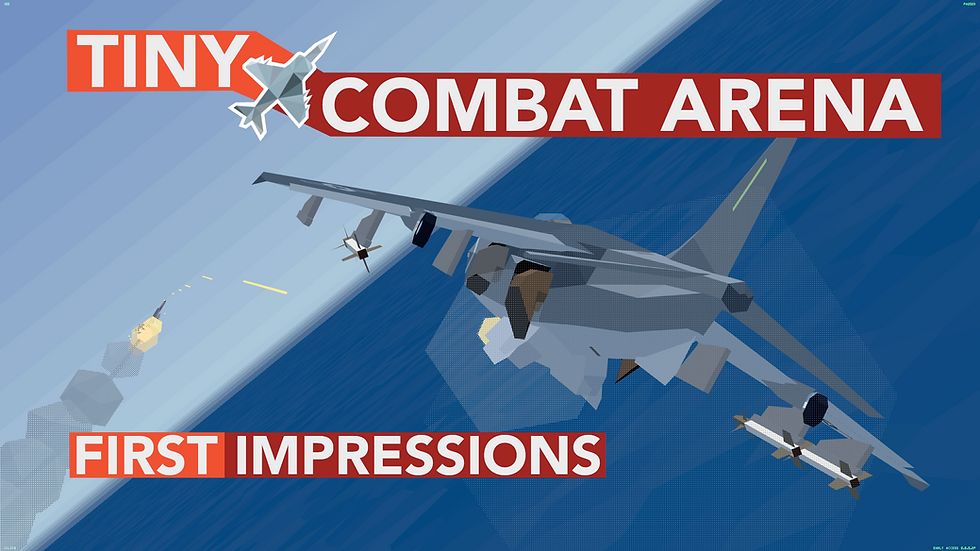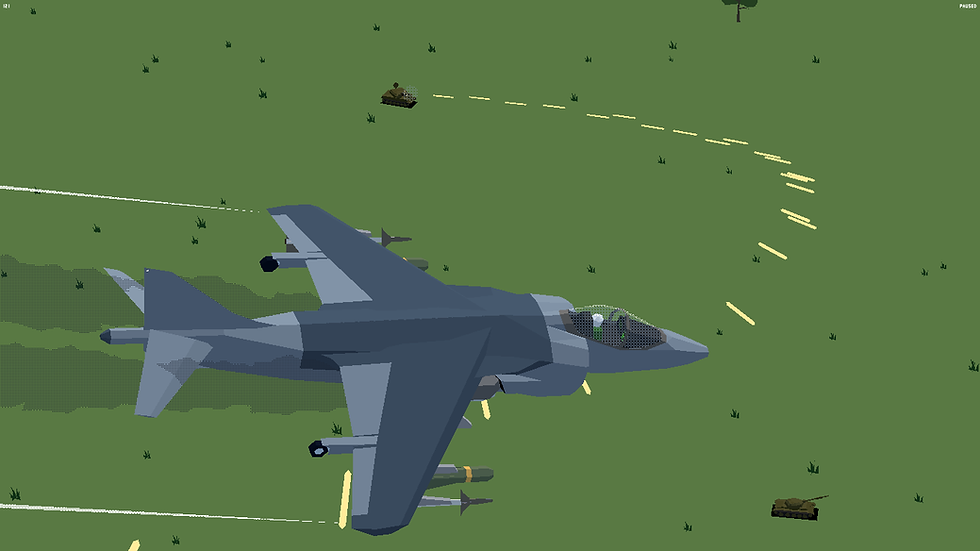Interview: Why485, developer of Tiny Combat Arena (Part 2/2)
- Aaron "Ribbon-Blue" Mendoza

- Dec 1, 2020
- 7 min read
Updated: Sep 23, 2022
The second part of our 8-page interview with Why485, developer of Tiny Combat Arena. We continue to focus on his motivations and thoughts while still developing this flight simcade. Like the first part of our interview, we are incorporating pictures and .gifs provided to us by the developer.

Up to this point, what have been the top three most difficult things to develop?
1. By far the most difficult aspect of the game is the Arena mode and associated UI. There's a lot of moving parts and it's almost like building a separate game on top of the flying game. I'm not a UI/UX designer at all, so I'm basically flying blind on the look and workflow for it. The difficulty of not having a clear vision of exactly what the map screen should look or work, is only compounded by how difficult it is to create UI of any kind.
It doesn't help that I've created a lot of problems for myself in trying to make so many aspects of the game pixel perfect and work at low resolutions, despite nobody actually playing at those resolutions. Honestly, at some point I'd love to redo all of the UI in the game with the guidance of a UI/UX designer.
2. Another major problem that I've had to overcome (and am still having issues with) is the floating point precision errors due to the scale of the game. This is a big topic that goes beyond just my game and could easily be its own article. Basically, the further away something gets from the center of the game world, the less precise the game can position it.
For the vast majority of games out there, this is a non-issue since nothing gets far away enough. However, for games that take place in large spaces with high speeds like a flight/space sim, it's a crippling problem. If you aren't writing your own engine, there's no good solutions to this, only workarounds of varying complexity and robustness. None of the accessible off the shelf engines have a true solution for this, since it's a niche use case and very non-trivial to support if the engine wasn't built with it in mind.
To be fair, Unreal Engine does have native support for one of the workarounds, something I know Project Wingman takes advantage of. Unigine, on the other hand, has recently been made available to the public, and it does have native support for large worlds with a double precision setting. However, it's locked behind a prohibitively expensive (for an indie developer at least) yearly subscription.
3. Last, but certainly not least, is probably the damage model. The Parsoft A-10 games were my main inspiration in what I wanted the physics of the game, particularly the damage and collisions, to feel like. Unfortunately for me, Parsoft set the bar very high. Trying to match that level of destruction and dynamic physics creates problems and requirements that have to be handled and designed for in almost every aspect of the game.
For example, I could have gotten away with a much simpler flight model if I didn't have to worry about the complex damage and collision model. There's still a lot of elements of the damage model that are unfinished, and edge cases which are still unhandled, to say nothing of the game-balancing implications it has. It wouldn't surprise me if I'm still tweaking the damage model right up until release.

Seeing as 1:1 realism will not be the focus of the game, what compromises will be made for the sake of enjoyment?
A lot more than I think people are expecting. The flight model is very physically based (necessarily so because of VTOL and damage), but beyond that I plan on streamlining a lot of the flying around, combat, and sensors. The goal here is to have a game inspired by real life mechanics, with the depth that comes with them, but to be ready to exaggerate and gamify them to make for a better game.
A good example of that would be the way missiles work. In a typical arcade flying game, missiles have a constant speed and max turn rate, but not much else. In real life, missiles are affected by gravity, their motors burn out, and they lose speed when they turn. These three facts add a lot of depth, not just evading incoming missiles, but in launching your own. E.g. the higher you are relative to the target, the more energy your missile has to work with since it's going to be flying "downhill" to the target, and can glide longer once the motor burns out. There might be less missiles flying around than an arcade game, but each missile is a much bigger threat and is its own challenge to evade.
All that said, this still isn't a sim. Missile ranges will be shorter than real life, and missiles slower so that they're easier to see and evade kinematically. In general, I'd like to have a bigger emphasis on traditional dogfighting, and close range gun kills, than a realistic flight sim so you can watch the planes fall apart and tanks explode in cool ways.
It’s never fun dying in a game without knowing what happened, or if it was even your fault, so I want to give the player a very clear picture of what's going on through HUD elements, visual cues, and warnings.

With a part of the core gameplay loop now having been shown publicly on your video, what are the areas you will be focusing on to expand on what you have shown?
There's only one major gameplay mechanic that's not in place yet or has had much to show: mission planning. The Arena map needs to be a lot more informative than it is right now. For example, showing air defense engagement and effective ranges. I want players to get an intuitive understanding of what they're up against, along with having tools to lay down waypoints and create a flight plan.
The real difficulty with that though, is in designing the map and game such that planning is something players feel is actually helpful. I'm wary of the fact that I might spend a lot of time on all that, and nobody ends up using it since the game is too easy and lacks the depth to necessitate it.
I also have a lot of ideas on how to handle the HUD, which is very sorely under-developed at the moment. Lately I've been coming to the conclusion that I'll probably need to fall back onto on-screen magic displays to display all the information I want to, and to be able to display it in a way that's easily readable by the player. This is something I'll probably be prototyping out soon.

Your Sunday Challenge streams have been an informative way for people to learn about aviation related game development. Is that what you had planned from the beginning?
I didn't specifically plan to talk about aviation related things, but I guess that was inevitable considering the kinds of things I typically work on. On Sundays, I generally make an effort to not work on my game, but sometimes there’s some programming concept or game mechanic floating around in my head that I want to experiment with. Doing so in the context of the game itself can be difficult, since there's already so many moving parts. I like making mini-projects to prototype that sort of thing.
The best example of this was loading of plaintext JSON files for gameplay relevant data (Tiny X-Wing) which ended up changing the direction of basically every feature implemented into Tiny Combat since then. So much of the game's data is now stored in easy to edit text files instead of locked away in the Unity Editor.
Do you have any advice or software suggestions for others thinking about trying their hand at aviation focused game development?
Realism is way overrated. People will always tell you they want more realism, but I don't think most understand the far-reaching implications it has. A common design trap is the idea that adding realism makes a game better.
I think a lot about the Jane's series of games and how they're so much fun and so beloved by the flight sim community, and how those games are a lot closer to Ace Combat style games than I think most fans would ever admit. What Jane's does so brilliantly is that it dresses up its very arcade gameplay in real life acronyms, concepts, a licensed name with weight, and a very grounded presentation, to trick people into thinking it's a simulator.
On a mechanical level, it's pretty much an arcade flying game, but if you had a button to manually turn your radar on, and had limited missiles. The Jane's Fighters series practically wrote the book on how to gamify modern air combat into what people think modern air combat is like.
Unless you are specifically setting out to make a high fidelity simulator (which I don't recommend for a multitude of reasons) I think it's far more important that your game feels realistic, rather than actually being realistic. It's a fine line to walk, and it's something I worry about with my own game all the time. The best examples of the genre know how to walk that line, and are confident that their design decisions make for a better experience overall.

For the final question, I have to ask what has been on everyone's mind. Do you have a general idea of when a new demo or potential launch date for Tiny Combat Arena would be?
I do!
This has been a very informative interview, thank you for your time. Good luck with the rest of your game development, we'll be watching for future updates!
Thank you for giving me this opportunity!
Before I go though, I need to give a shoutout to Project Wingman, which if it’s not already out by the time this is published, should be in a few days. It’s an arcade jet fighter game that a friend of mine has been working on for about 5 years now.
RB was tired of Bamco not making Ace Combat games anymore, so he decided to learn how to make games, everything from 3D modeling to programming, just to make his own. It’s genuinely inspirational, and I’m so proud to see it finally come to completion. I’ve already played a little of it and it deserves every bit of success that I’m confident it will see.

About the Interviewer
Aaron "Ribbon-Blue" Mendoza

Co-founder of Skyward Flight Media. After founding Electrosphere.info, the first English Ace Combat database, he has been involved in creating flight game-related websites, communities, and events since 2005. He explores past and present flight games and simulators with his extensive collection of game consoles and computers. Read Staff Profile.
































.png)